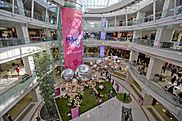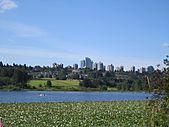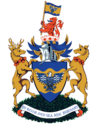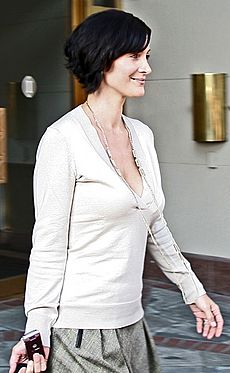Burnaby facts for kids
Quick facts for kids
Burnaby
|
|||||
|---|---|---|---|---|---|
|
City
|
|||||
| City of Burnaby | |||||
|
From top, left to right: Metrotown skyline, Brentwood Town Centre station on the Millennium Line, Metropolis at Metrotown mall, Deer Lake Park, Burnaby Mountain and the Burrard Inlet, Cherry blossom bloom on a residential street, Brentwood, Metrotown, and Edmonds skylines
|
|||||
|
|||||
| Motto(s):
By River and Sea Rise Burnaby
|
|||||

Location of Burnaby in Metro Vancouver
|
|||||
| Country | Canada | ||||
| Province | British Columbia | ||||
| Regional district | Metro Vancouver | ||||
| Established | 1891 | ||||
| Incorporated as a district municipality | September 22, 1892 | ||||
| Incorporated as a city | September 22, 1992 | ||||
| Named for | Burnaby Lake | ||||
| Seat | Burnaby City Hall | ||||
| Government | |||||
| • Type | Mayor–council government | ||||
| • Body | Burnaby City Council | ||||
| Area | |||||
| • Total | 96.6 km2 (37.3 sq mi) | ||||
| • Land | 90.57 km2 (34.97 sq mi) | ||||
| Highest elevation | 370 m (1,214 ft) | ||||
| Lowest elevation | 0 m (0 ft) | ||||
| Population
(2021)
|
|||||
| • Total | 249,125 | ||||
| • Estimate
(2023)
|
279,948 | ||||
| • Rank |
|
||||
| • Density | 2,750.7/km2 (7,124/sq mi) | ||||
| Time zone | UTC−08:00 (Pacific Standard Time) | ||||
| • Summer (DST) | UTC−07:00 (Pacific Daylight Time) | ||||
| Forward sortation area |
V3N, V5A – V5C, V5E, V5G – V5H, V5J
|
||||
| Area codes | 604, 778, 236, 672 | ||||
Burnaby is a city in British Columbia, Canada. It is located in the middle of the Burrard Peninsula. Burnaby is next to Vancouver to the west. To the north, it is near the District of North Vancouver across the Burrard Inlet. To the east, you'll find Port Moody and Coquitlam. New Westminster and Surrey are to the southeast, across the Fraser River. Richmond is to the southwest.
Burnaby became a city in 1992, exactly 100 years after it was first set up in 1892. It is part of Metro Vancouver. Burnaby is the third-largest city in British Columbia by population. Only Vancouver and Surrey are bigger. What's cool about Burnaby is that a quarter (25%) of its land is made up of parks and open spaces. This is one of the highest amounts in North America.
You can find the main campuses of Simon Fraser University (SFU) and the British Columbia Institute of Technology (BCIT) in Burnaby. Many high-tech companies are also here. These include Ballard Power Systems (which makes fuel cells), Clio (legal software), D-Wave Systems (quantum computing), General Fusion (fusion power), and EA Vancouver (video games).
Burnaby is also home to Metropolis at Metrotown. This is the biggest shopping mall in British Columbia. It's also one of the largest and most visited malls in Canada. The city has Canada's largest film and TV production studio. More than 60% of BC's sound stages are in Burnaby. This helps the city be a big part of "Hollywood North".
The city has a fast train system called SkyTrain. It uses the Expo Line and Millennium Line. Metrotown station is one of the busiest stations in the whole Vancouver area.
Contents
- Burnaby's Past: A Look Back in Time
- Exploring Burnaby's Geography and Land Use
- People and Cultures in Burnaby
- Burnaby's Economy and Businesses
- Learning in Burnaby: Schools and Universities
- Arts and Culture in Burnaby
- Sports and Recreation in Burnaby
- Getting Around Burnaby: Transportation
- Famous People From Burnaby
- Burnaby's Sister Cities
- See also
Burnaby's Past: A Look Back in Time
Early Days: Before 1850
Long ago, the first people to live in this area were the Coast Salish Nations. They spoke languages like hən̓q̓əmín̓əm̓ and Sḵwx̱wú7mesh. Important places like Burnaby Mountain and Deer Lake are part of their old stories. The northern shore of Burnaby was once the site of a big battle. This battle was between the attacking Lekwiltok and the defending Musqueam people.
The Coast Salish people in BC and Washington state were very many. They used special ways to save food, like cranberries from the marshlands. This helped their communities grow. They also traveled through Burnaby to fish for eulachon and sockeye salmon. But when early European explorers came, they brought diseases. These diseases sadly made the Indigenous population much smaller. Because of this, and because Indigenous farming didn't change the land much, Europeans wrongly thought the land was empty.
Becoming a Town: 1850 to 1990
In 1858, the Fraser Canyon Gold Rush brought many people looking for gold. This led to the creation of the Colony of British Columbia. New Westminster became its capital.
Settlers could claim land by clearing forests and building homes. But Indigenous people were not allowed to do this. The Royal Engineers took land from Indigenous people, sometimes using force. They built roads like North Road and Kingsway on these lands. Logging also destroyed forests that Indigenous people relied on for food.
The city of Burnaby is named after Burnaby Lake. The lake itself was named after Robert Burnaby. He was an explorer and a lawmaker. In 1859, he surveyed the freshwater lake in the middle of the city. Colonel Richard Moody then named it Burnaby Lake.
Burnaby was officially set up in 1891. It became a municipality a year later in 1892. In the same year, a tram line was built. It connected Vancouver, Burnaby, and New Westminster.
Modern Burnaby: Recent Times
As Vancouver and New Westminster grew, Burnaby also started to grow. At first, it was a farming area. It supplied food to nearby markets. Later, it became a key route for travel between Vancouver, the Fraser Valley, and the Interior of British Columbia. The SkyTrain's Expo Line helped this growth continue into the 21st century.
Burnaby became one of Vancouver's first suburbs. Many "Mid-Century Vernacular" homes were built for new residents. The opening of BCIT in 1960 and SFU in 1965 helped Burnaby become more like a city. In 1992, exactly 100 years after it was formed, Burnaby officially became a city.
Since the 1970s, Burnaby has changed. It moved away from natural resource industries. Instead, it focused on high-tech services and technology. BCIT and SFU helped with research and new ideas. For example, old factories near Still Creek became film production studios. This growth in media production has made Burnaby a big part of "Hollywood North."
Exploring Burnaby's Geography and Land Use
Burnaby covers about 96.6 square kilometers. It is right in the middle of the Metro Vancouver Regional District. The city has four main busy areas, called "town centers." These are Lougheed, Edmonds, Metrotown, and Brentwood. The city's government buildings and cultural spots are in the Deer Lake area.
Burnaby is between Vancouver to the west and Port Moody, Coquitlam, and New Westminster to the east. The Burrard Inlet is to the north, and the Fraser River is to the south. Burnaby, Vancouver, and New Westminster together make up most of the Burrard Peninsula. Burnaby's elevation goes from sea level up to 370 meters on Burnaby Mountain. Because it's higher up, Burnaby usually gets more snow in winter than Vancouver or Richmond. Overall, Burnaby has many hills, ridges, valleys, and flat areas.
Burnaby has many businesses and factories. Metropolis at Metrotown is the biggest shopping mall in British Columbia. You can also find malls in Brentwood and Lougheed town centers. Even with all this, Burnaby has one of the highest amounts of park land per person in North America. It also keeps some land for farming, especially along the Fraser River in the Big Bend area.
Parks, Rivers, and Lakes
Burnaby has many beautiful parks and waterways. Some of the main ones are Central Park, Robert Burnaby Park, Kensington Park, Burnaby Mountain, Still Creek, the Brunette River, Burnaby Lake, Deer Lake, Squint Lake, and Barnet Marine Park.
Burnaby's Weather
Burnaby has a mild climate. Summers are usually warm and dry, while winters are cool and rainy. The weather station at Simon Fraser University is high up on Burnaby Mountain. So, its records show cooler temperatures and more snow compared to other parts of the city.
| Climate data for Burnaby (Simon Fraser University) 1981–2010 at 365 metres | |||||||||||||
|---|---|---|---|---|---|---|---|---|---|---|---|---|---|
| Month | Jan | Feb | Mar | Apr | May | Jun | Jul | Aug | Sep | Oct | Nov | Dec | Year |
| Record high °C (°F) | 16.5 (61.7) |
18.5 (65.3) |
23.0 (73.4) |
28.0 (82.4) |
33.0 (91.4) |
31.1 (88.0) |
34.0 (93.2) |
33.9 (93.0) |
34.5 (94.1) |
26.5 (79.7) |
19.4 (66.9) |
16.1 (61.0) |
34.5 (94.1) |
| Mean daily maximum °C (°F) | 5.8 (42.4) |
6.8 (44.2) |
9.3 (48.7) |
12.4 (54.3) |
15.6 (60.1) |
18.2 (64.8) |
21.2 (70.2) |
21.2 (70.2) |
18.0 (64.4) |
12.0 (53.6) |
7.5 (45.5) |
5.1 (41.2) |
12.7 (54.9) |
| Daily mean °C (°F) | 3.6 (38.5) |
4.3 (39.7) |
6.2 (43.2) |
8.7 (47.7) |
11.8 (53.2) |
14.4 (57.9) |
17.0 (62.6) |
17.2 (63.0) |
14.6 (58.3) |
9.5 (49.1) |
5.3 (41.5) |
2.9 (37.2) |
9.6 (49.3) |
| Mean daily minimum °C (°F) | 1.4 (34.5) |
1.7 (35.1) |
3.1 (37.6) |
4.9 (40.8) |
7.9 (46.2) |
10.5 (50.9) |
12.7 (54.9) |
13.2 (55.8) |
11.1 (52.0) |
7.0 (44.6) |
3.0 (37.4) |
0.8 (33.4) |
6.5 (43.7) |
| Record low °C (°F) | −13.9 (7.0) |
−14 (7) |
−8 (18) |
−3.3 (26.1) |
−0.5 (31.1) |
3.9 (39.0) |
5.0 (41.0) |
3.3 (37.9) |
2.0 (35.6) |
−7 (19) |
−14 (7) |
−19.4 (−2.9) |
−19.4 (−2.9) |
| Average precipitation mm (inches) | 280.9 (11.06) |
178.4 (7.02) |
182.1 (7.17) |
154.4 (6.08) |
120.0 (4.72) |
101.4 (3.99) |
64.7 (2.55) |
64.5 (2.54) |
92.2 (3.63) |
210.1 (8.27) |
311.6 (12.27) |
249.8 (9.83) |
2,009.9 (79.13) |
| Average rainfall mm (inches) | 256.5 (10.10) |
163.2 (6.43) |
171.2 (6.74) |
152.7 (6.01) |
119.9 (4.72) |
101.4 (3.99) |
64.7 (2.55) |
64.5 (2.54) |
92.2 (3.63) |
209.8 (8.26) |
303.6 (11.95) |
220.8 (8.69) |
1,920.7 (75.62) |
| Average snowfall cm (inches) | 24.3 (9.6) |
15.1 (5.9) |
10.9 (4.3) |
1.7 (0.7) |
0.1 (0.0) |
0.0 (0.0) |
0.0 (0.0) |
0.0 (0.0) |
0.0 (0.0) |
0.2 (0.1) |
8.0 (3.1) |
29.0 (11.4) |
89.3 (35.2) |
| Average precipitation days (≥ 0.2 mm) | 20.5 | 16.2 | 18.9 | 16.1 | 14.9 | 13.5 | 7.4 | 6.8 | 10.3 | 17.1 | 21.6 | 19.8 | 183.1 |
| Average rainy days (≥ 0.2 mm) | 18.1 | 14.7 | 18.3 | 16.0 | 14.9 | 13.5 | 7.4 | 6.8 | 10.3 | 17.0 | 21.0 | 17.3 | 175.4 |
| Average snowy days (≥ 0.2 cm) | 4.0 | 2.5 | 2.0 | 0.54 | 0.04 | 0.0 | 0.0 | 0.0 | 0.0 | 0.09 | 1.8 | 4.5 | 15.5 |
| Source: Environment Canada | |||||||||||||
People and Cultures in Burnaby
| Population history | ||
|---|---|---|
| Year | Pop. | ±% |
| 1921 | 12,883 | — |
| 1931 | 25,564 | +98.4% |
| 1941 | 30,328 | +18.6% |
| 1951 | 58,376 | +92.5% |
| 1956 | 83,745 | +43.5% |
| 1961 | 100,157 | +19.6% |
| 1966 | 112,036 | +11.9% |
| 1971 | 125,660 | +12.2% |
| 1976 | 131,599 | +4.7% |
| 1981 | 136,494 | +3.7% |
| 1986 | 145,161 | +6.3% |
| 1991 | 158,858 | +9.4% |
| 1996 | 179,209 | +12.8% |
| 2001 | 193,954 | +8.2% |
| 2006 | 202,799 | +4.6% |
| 2011 | 223,218 | +10.1% |
| 2016 | 232,755 | +4.3% |
| 2021 | 249,125 | +7.0% |
| Source: Statistics Canada | ||
In 2021, Burnaby had a population of 249,125 people. This was an increase from 232,755 people in 2016. The city is home to many different cultures and people from all over the world.
For example, North Burnaby has long been a place for many Italian restaurants. The tall buildings in Metrotown have grown partly because people from China, Taiwan, and South Korea moved there in the 1990s. In 2021, people of Chinese background made up the largest group in Burnaby (33.3%). People of European background were the second largest (30.5%).
Languages Spoken in Burnaby
Burnaby is a very diverse city when it comes to languages. In 2006, more than half (54%) of Burnaby residents spoke a language other than English or French at home.
In 2016, English was the main language for 41.33% of the people. The next most common languages were Mandarin (14.53%), Cantonese (12.32%), and Tagalog (3.35%).
| Main Language | Number of People | Percentage |
|---|---|---|
| English | 91,850 | 41.33% |
| Mandarin | 32,295 | 14.53% |
| Cantonese | 27,375 | 12.32% |
| Tagalog | 7,435 | 3.35% |
| Korean | 7,010 | 3.15% |
| Punjabi | 5,000 | 2.25% |
| Spanish | 4,165 | 1.87% |
| Persian | 4,080 | 1.84% |
| Italian | 3,975 | 1.79% |
| Russian | 2,650 | 1.19% |
Religions in Burnaby
In 2021, almost half of Burnaby residents (48.4%) said they had no religion. About 35.2% were Christian. Other religions included Islam (5.6%), Buddhism (3.7%), Hinduism (3.1%), and Sikhism (2.8%).
Burnaby's Economy and Businesses
Burnaby has big shopping areas and many homes. It also has two rapid transit lines. The city is home to technology research, business parks, and film studios like The Bridge Studios. You can also find TV stations here, such as Global TV.
Many major technology companies have their main offices in Burnaby. These include Ballard Power Systems (fuel cells), D-Wave Systems (quantum computing), Clio (legal tech), and Electronic Arts Canada (video games).
Metropolis at Metrotown is in the Metrotown area, which is like Burnaby's downtown. It is the largest mall in British Columbia. It is also one of the biggest and most visited malls in Canada.
Big industrial companies like Chevron Corporation and Petro-Canada refine oil near the Burrard Inlet. Other companies with large offices in Burnaby include Ritchie Bros. Auctioneers, Pacific Blue Cross, and Nokia.
Learning in Burnaby: Schools and Universities
Public Schools
School District 41 manages education in Burnaby. It has 41 elementary schools and 8 secondary schools. Over 24,000 students attend these schools. The district also offers programs for adults and international students. There is also a French immersion program.
The British Columbia School for the Deaf is located at Burnaby South Secondary School.
Higher Education
Simon Fraser University (SFU) has its main campus on top of Burnaby Mountain. It has over 30,000 students. SFU is known as one of Canada's top universities.
The main campus of the British Columbia Institute of Technology (BCIT) is also in Burnaby. It opened in 1964 and has more than 49,000 students. A new Health Science Centre is being built. It will be very modern and will teach 7,000 students.
Arts and Culture in Burnaby
Burnaby has several museums that show off the city's history and culture. The Burnaby Village Museum is an outdoor museum. It looks like a Canadian village from the 1920s. The Nikkei National Museum & Cultural Centre opened in 2000. It helps people learn about Japanese Canadian culture and has a Japanese garden.
The Burnaby Public Library started in 1954. It now has four locations across the city. These are the Bobbie Prittie Metrotown, McGill, Tommy Douglas, and Cameron branches. The library system has millions of items and gets thousands of visitors every day.
Many cultural places are found near Deer Lake Park. These include the Burnaby Art Gallery, the Shadbolt Centre for the Arts, and the Burnaby Village Museum.
The Michael J. Fox Theatre is a community theatre. It is located inside Burnaby South Secondary School.
Sports and Recreation in Burnaby
Burnaby's main stadium is Swangard Stadium. It is located in Central Park (Burnaby) and was built in 1969. This stadium used to be home to the Vancouver 86ers soccer team.
Burnaby also helped host the 1973 Canada Games with New Westminster.
The Burnaby Velodrome is a special track for bicycle racing. It hosted a national championship in 2014.
In 2014, Burnaby was the host city for the 2014 IQA Global Games. This was a big international championship for the sport of quidditch.
Getting Around Burnaby: Transportation

The main control center for the SkyTrain is in Burnaby. It makes sure the Expo Line and Millennium Line run smoothly. A new control center is being built to help with more train riders.
The Expo Line, finished in 1986, runs through the south of Burnaby. The Millennium Line, finished in 2002, follows Lougheed Highway. The SkyTrain has helped connect Burnaby to New Westminster, Vancouver, and Surrey. It has also led to more buildings in areas like Lougheed Town Centre, Brentwood Town Centre, Edmonds–Highgate, and especially Metrotown.
Major roads that cross Burnaby from north to south include Boundary Road and North Road. Roads that connect Burnaby's neighboring cities from east to west include Hastings Street and Kingsway.
Since the 1990s, Burnaby has built over 70 kilometers of bike paths and trails.
The city also has a bus system run by the Coast Mountain Bus Company. This is part of TransLink, the region's transportation authority. The 49 bus route, which goes between Metrotown and the University of British Columbia, is one of the busiest bus routes in the area.
Burnaby has a plan for transportation until 2050. It aims to have zero traffic deaths. It also wants 75% of all trips to be by public transit or active ways like biking. The plan also hopes to remove all vehicle emissions.
Famous People From Burnaby
- Karl Alzner, NHL hockey player
- Glenn Anderson, former NHL hockey player
- Andrea Bang, actor, known for Kim's Convenience
- Michael Bublé, singer
- Christy Clark, former premier of British Columbia
- Kris Chucko, NHL hockey player
- Ian James Corlett, voice actor, writer, and TV producer
- Robin Esrock, travel writer and TV host
- Michael J. Fox, Canadian-American actor
- Kaleigh Fratkin, professional ice hockey player
- Jacob Hoggard, lead singer of Hedley
- Joe Keithley, musician and Burnaby politician
- Braam Jordaan, entrepreneur, filmmaker, animator, and activist
- Eagle Keys, CFL football player and coach
- Jason LaBarbera, NHL hockey player
- Brad Loree, movie stuntman
- Kenndal McArdle, former NHL hockey player
- John H. McArthur, Harvard Business School dean
- Darren McCarty, NHL hockey player
- Carrie-Anne Moss, movie and TV actress
- Dave Nonis, former senior vice president for the Toronto Maple Leafs
- Ryan Nugent-Hopkins, NHL hockey player
- Mark Olver, NHL and KHL hockey player
- Tyler O'Neill, MLB player for the Boston Red Sox
- Buzz Parsons, NASL soccer player and coach
- Colin Percival, computer scientist
- Dick Phillips, MLB baseball player and team manager
- Roy Radu, Rugby union player
- Svend Robinson, former federal politician
- Cliff Ronning, former NHL hockey player
- Joe Sakic, former NHL hockey player
- Mike Santorelli, NHL hockey player
- Murray SawChuck, Las Vegas-based magician
- Gurv and Harv Sihra, professional wrestlers
- Josh Simpson, USL soccer player
- Christine Sinclair, NWSL soccer player and captain of the Canadian Women's National Soccer Team
- Don Taylor, sportscaster
- Patrick Wiercioch, NHL hockey player
- Greg Zanon, AHL and NHL hockey player
Burnaby's Sister Cities
Burnaby has four sister cities around the world:
- Kushiro, Hokkaido, Japan (since 1965)
- Mesa, Arizona, United States (since 1998)
- Hwaseong, Gyeonggi-do, South Korea (since 2010)
- Zhongshan, Guangdong, China (since 2011)
See also
 In Spanish: Burnaby para niños
In Spanish: Burnaby para niños

















